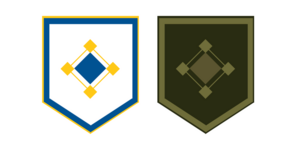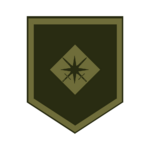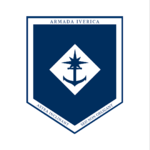Republican Armed Service
| Military of The Republic of Iverica | |
|---|---|
| Armaté Servissio D'República Iverica | |
 | |
| Motto | Gloria Fortis Miles |
| Founded | Guardia Expediciónare: 1620 Guardia Peninsulares: 1650 |
| Current form | Armaté Servissio D'República Iverica: 1820 |
| Service branches | Guardia Civil (Paramilitary) |
| Headquarters | Corregidor Comande Superiore (Corregidor High Command) |
| Leadership | |
| Commander-in-Chief (Executive) | Franso Deitorr |
| Minister of Defence | Ricardo Ibanes |
| Commander-in-Chief (Military) | CCO. Ferran-Arnau Macharius |
| Personnel | |
| Conscription | No |
| Available for military service | 8,007,694 males, age 17-49 (2019 est.), 7,962,099 females, age 17-49 (2019 est.) |
| Fit for military service | 7,775,889 males, age 17-49 (2019 est.), 6,342,945 females, age 17-49 (2019 est.) |
| Reaching military age annually | 323,699 males (2019 est.), 320,829 females (2019 est.) |
| Active personnel | 540,000 |
| Expenditure | |
| Budget | $126.990 billion (FY17) |
| Percent of GDP | RAS-2020: 6% Nominal: 2.5% |
The Republican Armed Service (Iverican: Armaté Servissio D'República Iverica) is the official militarised force of the Republic of Iverica. The RAS is tasked with the defence of the state and its citizens. Should it be necessary, the Service will be tasked with the prosecution of war against another state. It consists of the Exersito, Armada, Fuersas L'Aire and the Guardia Civil.
The Service employs only volunteering citizens. The RAS has a total of 540,000 enlisted men and women with a darft potential estimated to be in excess of 9 million. The Primo of Iverica serves as the Commander-in-Chief, though command of the Armed Service is mainly relegated to the Júnt-Capos dei Armaté Servicio (JCAS), led during wartime by the Capo-General dei Armaté Servicio, and in peacetime by the Ministero dei Defensa.
History
The history of Iverican military forces in the continent of Argis dates to September of 1620, with the creation of the Guardia Expendiciónare, even before the Narvic Blood Compact and the subsequent Consitution of the 1st Republic marked the establishment of the Republic of Iverica and the renaming of the provisionary forces to the Guardia Peninsulare. The Armada Iverica and the Tercios D'República, both established on the same date, were created in as successors to the provisionary Armada and infantry forces by the Iveric exodites during the Gran Viatge in order to defend the new nation against marauding Alharun and Argic kingdoms.
During the reformation in 1750, shortly after the Iverican Civil War, the Peninsular Guard was replaced with the "Exersito Iverica" and the joint entity know as the Republican Armed Service was formed thereafter. The Peninsular Guard now only applies to the Guardia Civil standing forces utilised in case of invasion or internal crises.
In 1920, the Fuersas L'Aire was formed in order to respond to neighbouring countries' growing dependence on aircraft for both civil and military use.
General Doctrine
The RAS is concentrated on a defensive and power-projection focus. Its composition and expenditure allocation places great emphasis on naval power and naval air power, with the Navy being the largest and lead branch with responsibilities ranging from national defence to foreign aid. The branches of the Exercisto and Air Force primarily serve logistical, fire support, and defensive roles, as their doctrines are built on the support of the Navy and defence of the homeland as top priorities.
Due to its geographical position between the Mediargic Sea, Oriental Ocean, and Argic Ocean, the Republic of Iverica must defend its peninsular and archipelagic territories with a strong naval presence. Its strategic position at the centre of heavy maritime traffic means that it must project its military strength over shipping routes that feed and profit the nation's main industry of components manufacturing. Additionally, the RAS build-up of naval power is effective for executing and upholding Iverican foreign policy which has grown more involved with external affairs over the past decade.
Tactics and strategies utilised by the RAS typically emphasise an organised use of speed and aggression to create a maximum shock effect on attackers or defenders. RAS doctrine allows for commanders to creatively affect regulations to provide greater combat flexibility and more localised control of operations. Commanders are often able to positively affect the speed and coordination of their subordinate elements by applying measures such as vehicle jury-rigging, altered SOPs on resource use and REDCON procedure, and altered composition of non-essential field kit. This level of operational freedom, when maintained with effective and disciplined communication, allows RAS units to seize objectives quickly, to execute a speedy and effective disruption of enemy networks, and to preemptively exploit strategic positions.
Often, these operating procedures are supplemented with combined-arms cooperation for greater effect. On a whole, two or more branches working in tandem to deliver shock and disruption on both tactical, operational, and strategic levels define the RAS's doctrine as manoeuvrable, flexible, and unconventional.
Organization
Command of the Armed Service rests with the Republic's Primo under counsel from the Júnt-Capos. The Júnt-Capos typically assemble at the military headquarters of Corregidor High Command, Nou Tacalonia, though auxiliary commands are scattered around the peninsula in case of a directed strike at the military's command structure.
The Armed Service is subdivided into 4 major service branches: Exersito, Armada, Fuersas L'Aire, and Guardia Civil. Each branch maintains a separate headquarters, command structure and training programme. Each branch is also required to maintain a Regimental Command base in every state as well as (at least) one Joint-Forces Station (JFS) with each other branch allowing for greater cooperation capability with other branches.
From the High Command, orders are passed to the Regimental Commands in each state or region or to Division Commands in foreign theatres. For the Armada, orders from Corregidor are passed to either the fleet flagship or the flotilla flagship.
Júnt-Capos dei Armaté Servicio
Known as "Joint Chiefs of the Armed Service", in common language, this body is composed of 8 members from all branches of service, the Executive Ministry, and the Legislature. Collectively the body represents the Republic of Iverica's command of all military forces during wartime. It is composed of the Capo-General, Capo dei Exersito, Capo-Almirante dei Armada, Capitan-Commandante dei Fuersas-Marinas, Capo dei Fuersas L'Aires, Capo dei Guardia Civil, Minister of Defence, and the Cámra Consul. During a wartime setting, the JCAS meets via secure telecommunication channels to coordinate a Combined-Arms effort to achieve the resolution to any conflict the Republic of Iverica may be faced with. It implements its own policies and procedures to see to a quick and efficient decision-making process.
Structure
The Commander-in-Chief (Capo-Comandante) of the Armed Service is the Primo of Iverica, currently Primo Franso E. Deitorr.
The Minister of Defence (as peacetime chairperson) and Capo-General (wartime counterpart) oversee operations of RAS. They also oversee such agencies as the Lideratge, Comando, and the Military subsidised industries. However, military policy is ultimately directed by the Executive Ministry.
- Ministerio dei Defensa: is the lead organisation, highest command and management of the Republican Armed Service.
- Júnt-Capos dei Armaté Servicio: is the leading agency all levels of the RAS, command all of the armed forces, which functions to ensure combat readiness of the armed forces and manage all military activities in peace and war.
Outside Regular Structure:
- Oficina dei Intelligensia Militar: is an intelligence agency of the RAS and its subordinate offices.
- Oficina dei Technicia Militar: is the agency in charge to ensure equipped technical means of war for each unit.
- Oficina dei Industria Militar: is the agency in charge of managing military industry, both public and private.
[ORGANISATION TREE HERE]
Budget
The fiscal year 2000 saw a dramatic change in military spending, from the nominal 4% of GDP increasing to roughly 4.8% and increasing again to 6%, nearly $126 Billion standard units in the fiscal year of 2010. The large increase was brought about by a modernisation initiative R.A 2310 known as "RAS 2020". R.A 2310 created a temporary and significant increase in the funding of the RAS specifically directed towards re-organisation, future planning, and technological improvements focusing on a long-term goal to establish a multi-tiered defence structure with combined arms and greater battlespace control in mind. The programmes of the initiative have so far developed systems dedicated to greater intelligence gathering capabilities (Phaethon System), communication, command, and coordination systems (C4I+) as well as modular systems (MIMiK System), and smaller, more widespread changes like the introduction of the intermediate 7x43mm cartridge.
Recent allotments have also seen an increase in overseas peacekeeping and defence expenditures. Since the modernisation initiative's restructuring of the Homeland Defence Programme, funding initially spent on superfluous domestic projects and upkeep has been diverted towards Blue Water patrols and other overseas programmes.
By military department, $20.39 billion standard units were allocated for the Encícomando dei Exersito, $52.14 billion for the Encícomando dei Armada, $33.09 billion for the Encícomando dei L'Aire and $15 billion for MoD-wide spending.
By function, $24.3 billion was requested for personnel, $37.10 billion for operations and maintenance, $18.22 billion for procurement, $31.20 billion for research and development, $2.12 billion for revolving and management funds, $12.30 billion for military construction and $2.20 billion for family housing.
Mobilisation
Declaration of War
The sole power to issue a formal declaration of war rests with the Cámra Nasional dei Iverica, popularly called the Parliament. In an emergency session where the parliament must convene to discuss a possible declaration of war, the procedure requires a 2/3 quorum from the assembled Members of the Chamber to successfully issue the formal declaration.
Emergency Executive Decision
In the event the Parliament cannot convene within a 24-hour period of the pre-defined instance known as "A Risk of War and State of Emergency", the Primo of Iverica must convene with the JCAS to reach an informed decision to declare war. This executive power is known as the "Emergency Executive Declaration" and follows the Primeal line of succession if the Primo is deceased or incapacitated.
Mobilisation without Formal Declaration
The Executive Ministry is given the authority to mobilise the RAS without a formal declaration of war from the Cámra Nasional. In the event of a sudden crisis, a single confirmation from either the Primo, the Minister of Defence, the Home Minister, or the Capo-General must be issued upon the emergence of a real and malicious threat. This act, known as Nation Security Statute 20-077 allows for the Palá dei Primo to determine a threat level in order to mobilise appropriate forces. These threat levels are known as "CONDEF" or "Condició dei Defensa", and are emplaced in escalating levels of force and security (1-5).
CONDEF Levels
| Readiness condition | Exercise term | Description | Readiness |
|---|---|---|---|
| CONDEF 1 | IMPETUS | Nuclear war is imminent | Maximum readiness |
| CONDEF 2 | TENDO | Next step to nuclear war | Armed Forces ready to deploy and engage in less than 6 hours |
| CONDEF 3 | DESTRICTUS | Increase in force readiness above that required for normal readiness | FLAIR ready to mobilize in 15 minutes |
| CONDEF 4 | TIBILIS | Increased intelligence watch and strengthened security measures | Above normal readiness |
| CONDEF 5 | VIGIL | Lowest state of readiness | Normal readiness |
Branches of Service
Personnel
| Component | Military | Enlisted | Officer | Civilian |
| 140,000 | 100,000 | 40,000 | 61,000 | |
| 200,000 | 160,000 | 40,000 | 90,000 | |
| 40,000 | 34,300 | 5,700 | 5,000 | |
| 120,000 | 82,500 | 37,500 | 58,000 | |
| File:GUARDIA CIVIL EMBLEM HERE Guardia Civil- Regulares | 40,000 | 30,000 | 10,000 | |
| Total Active | 540,000 | 406,800 | 133,200 | 214,000 |
| 25x25px Guardia Civil- Irregulares | 60,000 | 40,000 | 20,000 | |
| 25x25px Exersito Iverica Reserva | --- | --- | --- | |
| 25x25px Armada Iverica Tercio Reserva | --- | --- | --- | |
| 25x25px Armada Iverica Reserva | --- | --- | --- | |
| 25x25px Fuersas L'Aire Iverica Reserva | --- | --- | --- | |
| 25x25px United States Air Force Reserve | --- | --- | --- | |
| 25x25px Guardia Maritima Reserva | --- | --- | --- | |
| Total Reserves | --- | --- | --- | |
| Other MoD personnel | 29,833 |
Exersito
Main Article: [URL]
The Exersito is the ground-warfare branch of the armed service with 140,000 enlisted personnel several Army Groups and Corps. Around 95,000 of the Exersito personnel serve support roles, while the rest are considered combat servicepersons.
The Exersito's primary duties include the defence of the Iverican Homeland, garrison of structures and points in land-based objectives, construction of field facilities and equipment, logistical efforts and security in land deployment, peacekeeping and relief efforts.
[Divisióne Airevieri EMBLEM HERE]
The Exersito maintains a few notable divisions fulfilling specialised roles. The airborne division is composed of air-deployable light infantry supplied and supported by the Exersito Cuerpos L'Aire and the Fuersas L'Aire. Their combat personnel train rigorously with insertion by para-drop, advanced survival and acclimatisation to taiga, alpine, mountainous, and tundra environments.
Training and Role
They are trained specially as forward-observers, pathfinders, saboteurs, counter-insurgency forces, and highly-mobile disruptive units. Airevieri training prepares its units for the possibility that they may be cut-off from direct supply lines, and thus personnel are typically trained to be proficient in handling a wide array of foreign weaponry. Specialists are also trained with advanced navigation or linguistic skills that will aid a unit in staying mission-capable for the duration of their deployment.
Equipment
Airevieri equipment is also distinct from Exersito standard-issue. Apart from the usual, they are armed with bullpup rifles, light-anti armour weaponry, 40mm mortars, and are often supported air-deployable field guns. They are equipped with advanced observation, demolition, camouflage, and communication equipment engineered to be as compact and light-weight as is currently possible.
[Divisióne Alpinieri EMBLEM]
The 7a Alpinieri Divisióne, nicknamed "L'Pilar" (Del Pilar's Own), is a light infantry division based at Forta Navaerre, Nou Navaerre. Designated as a mountain warfare unit, the division is trained and equipped for fighting in rugged, elevated conditions. All members of the Alpinieri receive intense specialized training for fighting in mountainous, taiga, and Supra-Argic conditions.
While the units within the Alpinieri division are an established infantry division, the unit also maintains three specialised regiments (22nd Alpinieri, 77th Aplinieri, and 88th Aplinieri Regiments) designated as Special Operations Forces together with several Air-Assault capable units.
Training and Role
Selection for the standard Brigade Combat Units in the Alpinieri is gruelling, requiring success in a specialised assessment programme that focuses on physical as well as mental endurance in conditions ranging from bad weather to simulated escape & evasion. In comparison, selection for Alipineri SOF requires success in even greater tests of endurance in addition to greater technical expertise. Alpinieri SOF applicants are required to learn at least one foreign language (among a range including but not limited to: Narvic, Prymontian, Ahranaian, Common Slavic, or Harabic) while also passing acclimatisation tests requiring the development of a digestion capable of surviving off of foraged or hunted food items.
In a combat theatre, the Alpinieri are expected to field units equipped and trained in the complicated skill necessary for manoeuvering around highly elevated and irregular positions. Skills such as abseiling, mountain climbing, rafting, and the traversing of caves. In combined arms or joint-branch operations, the units primarily provide observation, reconnaissance, and area-denial of such terrain. In most cases, the Alpinieri are expected to deploy and fortify their positions well in advance of most units.
Armada Iverica
Main Article: [URL]
The Armada Iverica (ARIV) translates directly to "Navy of Iverica". It is Iverica's naval warfare service branch and one of the 4 main branches of the RAS, consisting of roughly 240,000 servicemen and women. The Armada is the RAS's largest and best-funded branch, receiving roughly 40% of the RAS annual budget. It incorporates a body of trained amphibious warfare personnel known as the Republican Marine Corps and an aerial complement known as the Armada Air Corps.
The Armada often acts as Iverica's primary resort in risky or tense foreign affairs, protecting citizens and interests abroad with the deployment of Carrier Strike Groups. Armada task units also police the ever-important shipping lanes in Iverica's surrounding strategic waters, maintaining order and Iverican influence over important straits and other marine avenues.
[MARINES EMBLEM HERE]
Cuerpos Tercio
The Republican Marine Corps (RMC) or Cuerpos Tercio dei República currently has a force of 40,000 marines inclusive of service battalions and support crews. The RMC functions as the Republic of Iverica's elite amphibious infantry body. The Corps not only serve as security for naval vessels but are the premier choice for honour guards in the Iverican government. Thus, all Iverican Embassies and a majority of foreign delegates are attached with a security detail of veteran marines.
The RMC primarily carries out amphibious assault and helicopter-borne operations. Marine doctrine is heavily focused on Third-Generation and Fourth-Generation strategies and tactics including but not limited to, Manoeuvre warfare, Counter-Insurgency, and Asymmetric warfare.
Given Iverica's geographical conditions and heavy naval focus, it is no surprise that the RMC is one of the best-equipped infantry bodies in the Armed Service. It rivals the Airborne Corps in terms of cost of training, equipment, and salary.
Fuersas L'Aire dei Iverica
Main Article: [URL]
The Fuersas L'Aire dei Iverica (FLAIR), serves as the primary aerial-warfare service branch of the Republican Armed Service. It is based mainly on terrestrial airfields and air bases, operating as a defensive and supporting force for other branches of the RAS.
The FLAIR operates air-superiority, multi-role, ground-attack, anti-ship, reconnaissance, transport, cargo, survey, and other utilities. Headquartered at Corregidor Air Base, the FLAIR is the second most well-funded branch of service, receiving 30% of the annual defence budget. It employs 120,000 personnel of varying ranks and duties.
Special Operations Command
Main Article: [URL]
The Iverican Special Operations Command (SOC) is a special division of the Republican Armed Service under direct authority from the Júnt Capos dei Armaté Servicio. SOC is not a branch of the RAS, but a specialised entity which exists to provide Iverica with a covert or direct action force capable of operating outside of regular protocol, responding to increasingly dynamic and hazardous scenarios.
Units within the SOC are formed in response to the growing threat of covert foreign action, deployment of WMDs, and 4th/5th generation warfare. While the regular four branches of the RAS are permitted to maintain special forces units, they rarely operate outside of a theatre of operation their branch of service has been assigned to. Units of the SOC are given highly specialised tasks which require training, dedication, and discretion outside of the normal expectations within regular RAS units.
[[File:|thumb|left|150px]]
Special Operación ét Agressiva Reconocimiento
SOAR
[[File:|thumb|left|150px]]
Para-Rescate
PARE
[[File:|thumb|left|150px]]
Securidade dei Special Armat
SWS-1
Guardia Civil of Iverica
Main Article: [URL]
The Guardia Civil of Iverica (GCI), is the fourth branch of the Republican Armed Service. It is a self-defence force tasked with the defence of home territories and provides a garrison of trained infantry for the ready response to civil unrest, natural disaster, or invasion. The GCI fills the role of a paramilitary law enforcement corps, using heavier weaponry than the ordinary constabulary.
Unlike the other three branches of service, the Guardia Civil falls under the direct command of the Home Ministry. During an invasion, this control is typically surrendered to the Júnt-Capos. This separation of powers is necessary to ensure that local government units can defend themselves in the event of revolution by the other branches of service
Organization
Many Guardia Civil personnel are irregulars who are trained and deputised but maintain other civilian jobs. There are approximately 80,000 regular servicepersons and roughly 200,000 irregular personnel. Combat training and equipment with automatic weapons, riot-control, and light fire support are issued depending on specialisation and seniority. The GCI is also tasked to maintain heavy response units in armoured vehicles, counter-terrorism units, and investigatory units.
Guardia Maritima
The Guardia Marítima is a special unit within the GCI which operates light coastal defence craft, river craft and search & rescue craft. It is tasked with protecting coastal and inland waters while at the same time, providing disaster-relief, maritime emergency response, and maritime rescue operations.
Guardia Doctrine
The Guardia Civil is strictly a self-defence force as the RAS charter bars the GCI from participating in an invasive action. The force maintains a focus of defensive operations, training their special and regular units with skills of field-fortification, asymmetrical warfare, and static defence.
In the event of an invasion, the GCI will typically begin an entrenchment and support phase, assisting the Exersito or other branches by clearing roads, policing civilians, maintaining order, securing and preparing vital infrastructures such as hospitals, armouries, motor pools, and staging zones for heavy use.
Should the Guardia Civil be confronted with a hostile foreign invader, they are permitted to shoot on sight, exercise other wartime law, and capture or detain enemy assets or personnel. The GCI prioritises the safety of civilians and must act accordingly, addressing first operations which best ensure the preservation of civilian life.
Tricontinental Defence Treaty
Main Article: Tricontinental Defence Treaty Organisation
The Tricontinental Defence Treaty Organisation (TRIDENT), is an intergovernmental military alliance between 6 Argic, Alharun, Thalassan and Marenesian nations. The alliance is based on the Tricontinental Defence Treaty that was signed on 25 January 2018. TRIDENT constitutes a system of collective defence whereby its independent member states agree to mutual defence in response to an attack by any external party. TRIDENT Headquarters are located in [Enter Location], while the Headquarters of the [Enter Organisation], is near [Enter Location].
The organisation conducted its first military intervention in the Verde Sea, to prevent the increase in military disparity in the area
Relevant Legislation
Nation Security Statute 20-077
This statute allows for the Palá dei Primo to determine a threat level in order to mobilise appropriate forces. These threat levels are known as "CONDEF" or "Condició dei Defensa", and are emplaced in escalating levels of force and security (1-5).
Furthermore, the statute defines and authorises the martial powers of the "Secundo" or Vice-Executive office in the event that snap decisions need by made while the Primo is otherwise unable to take action.
R.A 2100 "Martial Merits Act"
RA. 2100, called the Martial Merits Act promises full or partial scholarships for a promised service in the Republic's armed forces. Passed in 1751, the Martial Merits Act aimed to make specialised education more accessible to the general public while also supplementing armed forces manpower and impressing Iverican virtues upon the nation's youth.
Throught this legislative act, men and women may recieve free or more affordable education depending in exchange for a fixed period of service to the RAS. The Martial Merits Act is accessible only to youth from families falling under Tier C-E income earners (approx. median-low income earners).
R.A 2310 "RAS 2020"
RAS-2020 was designated as Republic Act- no. 2310 when enacted in September of 2000. The act is a large-scale and long-term reform, streamlining process, and technical modernisation initiative to supplement the aging equipment and procedures of the RAS. The act aims to achieve this using a temporary increase in defence spending from a nominal 4% of the GDP to 6%, returning to a nominal percentage by the year 2020, when economic gains and benefits from lowered upkeep spending come into effect


